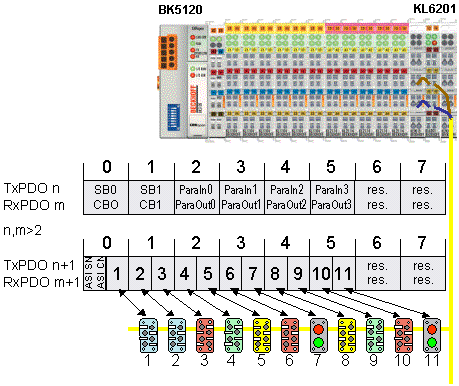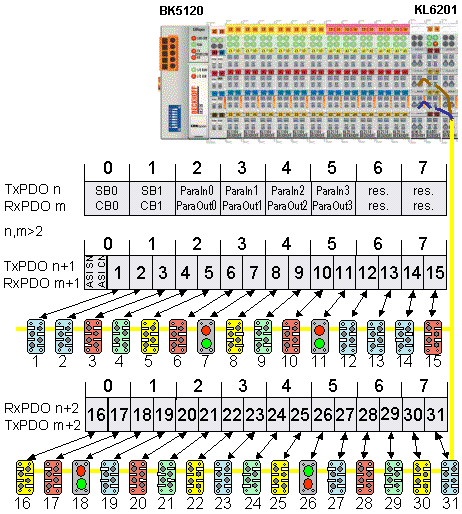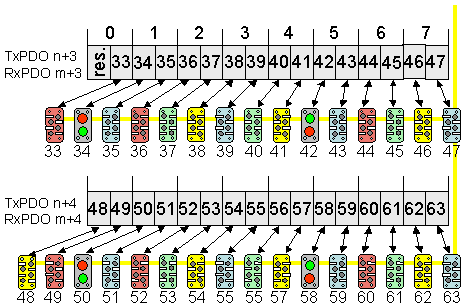KL6201/KL6211 at CANopen couplers
Chapter overview
This chapter comprises the following sections:
- Selecting the size of the process image
- Mapping of the process data
- 6-byte process image
- 12-byte process image
- 22-byte process image
- 38-byte process image
- Accessing parameters
Selecting the size of the process image
The size of the process image of the AS-i master terminal can be set to 6, 12, 22 or 38 bytes. This can be done with the KS2000 configuration software or via the fieldbus. To this end, parameter 0x20 has to be modified via the parameter data block (see AS-i parameter 0x20). The Bus Coupler must then be reset, after which it starts with the last selected process image size.
 | Process Images If the 22-byte or 38-byte process image is to be used under CANopen, the Bus Coupler may require a particular firmware version (see chapter Firmware version of the Bus Coupler). The delivered firmware version is shown on the back of the Bus Coupler (see example below). If required, the firmware can be updated via the serial interface (KS2000 cable required) or via CANopen (using the FC5101 fieldbus card, if firmware version C2 is already loaded on the Bus Coupler). |
 Fig.32: Specification of the firmware version of the BK5120 CANopen coupler
Fig.32: Specification of the firmware version of the BK5120 CANopen couplerMapping of the process data
Like for the CANopen Bus Couplers, the process image of the KL6201/KL6211 is mapped to several 8-byte data objects. The 8-byte data objects are located in the CANopen object directory at index 0x3000 (input data) or index 0x3100 (output data). The coupler automatically maps these objects to the first free PDO (from PDO3) during start-up.
6-byte process image
Parameter data block
The 6-byte process image only consists of the parameter data block, supplemented by 2 dummy bytes. This block is located at index 0x3000 and is fully mapped into a PDO.
In contrast to the other process images, the 6-byte process image does not support direct access to the process data of the AS-i slaves. The process data access must take place via the AS-i parameters 0x80 to 0x87 (digital slaves) or 0x204 to 0x27F (analog slaves).
The TxPDO (KL6201/KL6211 -> PLC) with the input data (index 0x3000) has following structure:
Dummy bytes | |||||||
|---|---|---|---|---|---|---|---|
Byte 0 | Byte 1 | Byte 2 | Byte 3 | Byte 4 | Byte 5 | Byte 6 | Byte 7 |
SB0 | SB1 | Para In 0 | Para In 1 | Para In 2 | Para In 3 | reserved | reserved |
The RxPDO (PLC -> KL6201/KL6211) with the output data (index 0x3100) has following structure:
Dummy bytes | |||||||
|---|---|---|---|---|---|---|---|
Byte 0 | Byte 1 | Byte 2 | Byte 3 | Byte 4 | Byte 5 | Byte 6 | Byte 7 |
CB0 | CB1 | Para Out 0 | Para Out 1 | Para Out 2 | Para Out 3 | reserved | reserved |
Key
SB n: status byte n
CB n: control byte n
Para Out n: Output parameter, byte n
Para In n: Input parameter, byte n
12-byte process image
Parameter data block
The first 8-byte object contains the parameter data block, complemented by 2 dummy bytes. This block is located at index 0x3000 and is fully mapped into a PDO.
The TxPDO (KL6201/KL6211 -> PLC) with the input data (index 0x3000) has following structure:
Dummy bytes | |||||||
|---|---|---|---|---|---|---|---|
Byte 0 | Byte 1 | Byte 2 | Byte 3 | Byte 4 | Byte 5 | Byte 6 | Byte 7 |
SB0 | SB1 | Para In 0 | Para In 1 | Para In 2 | Para In 3 | reserved | reserved |
The RxPDO (PLC -> KL6201/KL6211) with the output data (index 0x3100) has following structure:
Dummy bytes | |||||||
|---|---|---|---|---|---|---|---|
Byte 0 | Byte 1 | Byte 2 | Byte 3 | Byte 4 | Byte 5 | Byte 6 | Byte 7 |
CB0 | CB1 | Para Out 0 | Para Out 1 | Para Out 2 | Para Out 3 | reserved | reserved |
Key
SB n: status byte n
CB n: control byte n
Para Out n: Output parameter, byte n
Para In n: Input parameter, byte n
Process data block
The next 8-byte object contains the process data block with AS-i status nibble (ASI SN) and the AS-i input data. The next TxPDO (KL6201/KL6211 -> PLC) therefore has the following content:
Process data block | Dummy bytes | ||||||
|---|---|---|---|---|---|---|---|
Byte 0 | Byte 1 | Byte 2 | Byte 3 | Byte 4 | Byte 5 | Byte 6 | Byte 7 |
ASiSN + | ASiIn | ASiIn | ASiIn | ASiIn | ASiIn | reserved | reserved |
The next RxPDO (PLC -> KL6201/KL6211) contains the AS-i command nibble (ASI CN) and the AS-i output data:
Process data block | Dummy bytes | ||||||
|---|---|---|---|---|---|---|---|
Byte 0 | Byte 1 | Byte 2 | Byte 3 | Byte 4 | Byte 5 | Byte 6 | Byte 7 |
ASiCN + | ASiOut | ASiOut | ASiOut | ASiOut | ASiOut | reserved | reserved |
Key
ASiSN: AS-i status nibble
ASi CN: AS-i command nibble
ASiIn Slave x+y: Input data of the AS-i slaves x and y (one nibble per slave)
ASiOut Slave x+y: Output data of the AS-i slaves x and y (one nibble per slave)
For the 12-byte process image, the AS-i data are therefore mapped to the CANopen process data objects (PDOs) as follows:
 Fig.33: Mapping of the AS-i data to the CANopen process data objects for the 12-byte process image
Fig.33: Mapping of the AS-i data to the CANopen process data objects for the 12-byte process image22-byte process image
Parameter data block
See 12-byte process image.
Process data block
If the 22-byte process image was selected (AS-i slave addresses > 11 in use), dummy bytes are used for further process data (slave addresses 12 to 31). Furthermore, one further 8-byte object with process data is created for the slaves from 16 to 31 in index 0x3000 or 0x3100 and mapped into the next free PDO.
Process data block | |||||||
|---|---|---|---|---|---|---|---|
Byte 0 | Byte 1 | Byte 2 | Byte 3 | Byte 4 | Byte 5 | ... | Byte 15 |
ASiSN + | ASiIn | ASiIn | ASiIn | ASiIn | ASiIn | ... | ASiIn |
The next RxPDO (PLC -> KL6201/KL6211) contains the AS-i command nibble (ASI CN) and the AS-i output data:
Process data block | |||||||
|---|---|---|---|---|---|---|---|
Byte 0 | Byte 1 | Byte 2 | Byte 3 | Byte 4 | Byte 5 | ... | Byte 15 |
ASiCN + | ASiOut | ASiOut | ASiOut | ASiOut | ASiOut | ... | ASiOut |
Key
See 12-byte process image.
Accordingly, in the 22-byte process image the AS-i data are mapped to the CANopen process data objects (PDO) as follows:
 Fig.34: Mapping of the AS-i data to the CANopen process data objects for the 22-byte process image
Fig.34: Mapping of the AS-i data to the CANopen process data objects for the 22-byte process image38-byte process image
Parameter data block
See 12-byte process image.
Process data block
If the 38-byte process image was selected (AS-i slave addresses > 32 are used), a further 8-byte object with process data for AS-i slaves 33 to 63 is created in index 0x3000 or 0x3100 and mapped to the next free PDO.
Mapping of the AS-i data for slave addresses greater than 32 to the additional CANopen PDO for the 38-byte process image looks as follows (PDO n, PDO n+1, PDO n+2 as for the 22-byte process image):
 Fig.35: Mapping of the AS-i data to the CANopen process data objects for the 38-byte process image
Fig.35: Mapping of the AS-i data to the CANopen process data objects for the 38-byte process imageMapping example
A BK5120 (Bus Coupler for CANopen) has
- 78 digital inputs and 48 digital outputs
- 6 analog inputs and 4 analog outputs
- a KL5001 (SSI encoder interface: 4 byte inputs by default)
- a KL6001 (serial interface: 4 byte inputs and 4 byte outputs by default)
- a KL5111 (incremental encoder interface) (6-byte inputs and 6-byte outputs)
- A KL6201/KL6211 AS-i master terminal with default setting (22-byte process image)
PDO | Data contents (mapping) | Object | PDO | Data contents (mapping) | Object |
|---|---|---|---|---|---|
RxPDO1 | 5-byte digital outputs 1..48 | 0x6200, | TxPDO1 | 8-byte digital inputs 1...64 | 0x6000, |
RxPDO2 | 8-byte analog outputs 1..4 | 0x6411, | TxPDO2 | 4-byte analog inputs 1...4 | 0x6401, |
RxPDO3 | 4-byte serial interface | 0x2900, | TxPDO3 | 2-byte digital inputs 65...78 | 0x6000, |
RxPDO4 | 6-byte encoder outputs | 0x2D00, | TxPDO4 | analog inputs 5 and 6 | 0x6401, |
RxPDO5 | 8-byte AS-i master 1: parameter data block | 0x3100, | TxPDO5 | 8 bytes: 4-byte SSI and 4-byte serial interface | 0x2800, |
RxPDO6 | 8-byte AS-i master 1: Process data block outputs ASI slave 1...15 | 0x3100, | TxPDO6 | 6 bytes encoder input | 0x2C00, |
RxPDO7 | 8-byte AS-i master 1: Process data block outputs AS-i slave 16...31 | 0x3100, | TxPDO7 | 8-byte AS-i master 1: parameter data block | 0x3000, |
|
|
| TxPDO8 | 8-byte AS-i master 1: Process data block inputs AS-i slave 1...15 | 0x3000, |
|
|
| TxPDO9 | 8-byte AS-i master 1: Process data block inputs AS-i slave 16...31 | 0x3000, |
Access to the parameters of the KL6201/KL6211
The KL6201/KL6211 parameters are accessible via the parameter data block in the first receive process data object (RxPDO) and transmit process data object (TxPDO).
General examples for parameter access can be found in Chapter Access to AS-i parameters.